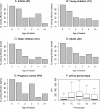Physical condition and maintenance of mosquito bed nets in Kwale County, coastal Kenya
- PMID: 23374429
- PMCID: PMC3572415
- DOI: 10.1186/1475-2875-12-46
Physical condition and maintenance of mosquito bed nets in Kwale County, coastal Kenya
Abstract
Background: Despite the extensive ownership and use of insecticide-treated nets (ITNs) over the last decade, the effective lifespan of these nets, especially their physical integrity, under true operational conditions is not well-understood. Usefulness of nets declines primarily due to physical damage or loss of insecticidal activity.
Methods: A community based cross-sectional survey was used to determine the physical condition and to identify predictors of poor physical condition for bed nets owned by individuals from communities in Kwale County, coastal Kenya. A proportionate hole index (pHI) was used as a standard measure, and the cut-offs for an 'effective net' (offer substantial protection against mosquito bites) and 'ineffective nets' (offer little or no protection against mosquito bites) were determined (pHI ≤88 (about ≤500 cm2 of holes surface area) and pHI of >88 (≥500 cm2 of holes surface area), respectively).
Results: The vast majority (78%) of the surveyed nets had some holes. The median pHI was 92 (range: 1-2,980). Overall, half of the nets were categorized as 'effective nets' or 'serviceable nets'. Physical deterioration of nets was associated with higher use and washing frequency. Young children and older children were found to use ineffective bed nets significantly more often than infants, while the physical integrity of nets owned by pregnant women was similar to those owned by infants. Estuarine environment inhabitants owned nets with the worst physical condition, while nets owned by the coastal slope inhabitants were in fairly good physical condition. The results suggest that bed nets are optimally utilized when they are new and physically intact. Thereafter, bed net utilization decreases gradually with increasing physical deterioration, with most net owners withdrawing physically damaged nets from routine use.This withdrawal commonly happens following 1.5 years of use, making bed net use the most important predictor of physical integrity. On average, the nets were washed twice within six months prior to the survey. Washing frequency was significantly influenced by the bed net colour and bed net age. Lack of knowledge on reasons for net retreatment and the retreatment procedure was evident, while net repair was minimal and did not seem to improve the physical condition of the nets. The "catch-up" bed net distribution strategies are sufficient for ensuring adequate ownership and utilization of 'effective nets' in the targeted groups, but bi-annual mass distribution is necessary to provide similar ownership and utilization for the other groups not targeted by "catch-up" strategies.
Conclusions: Monitoring and maintenance strategies that will deliver locally appropriate education messages on net washing and repair will enhance the effectiveness of malaria control programmes, and further research to assess ineffective nets need is needed.
Figures





Similar articles
-
Physical condition of Olyset® nets after five years of utilization in rural western Kenya.Malar J. 2013 May 10;12:158. doi: 10.1186/1475-2875-12-158. Malar J. 2013. PMID: 23663421 Free PMC article.
-
Comparing ownership and use of bed nets at two sites with differential malaria transmission in western Kenya.Malar J. 2016 Apr 14;15:217. doi: 10.1186/s12936-016-1262-1. Malar J. 2016. PMID: 27079380 Free PMC article.
-
Bed net care practices and associated factors in western Kenya.Malar J. 2019 Aug 14;18(1):274. doi: 10.1186/s12936-019-2908-6. Malar J. 2019. PMID: 31412865 Free PMC article.
-
Best practices for an insecticide-treated bed net distribution programme in sub-Saharan eastern Africa.Malar J. 2011 Jun 8;10:157. doi: 10.1186/1475-2875-10-157. Malar J. 2011. PMID: 21651815 Free PMC article. Review.
-
Reasons for mosquito net non-use in malaria-endemic countries: A review of qualitative research published between 2011 and 2021.Trop Med Int Health. 2024 Jul;29(7):647-656. doi: 10.1111/tmi.14006. Epub 2024 May 25. Trop Med Int Health. 2024. PMID: 38796689
Cited by
-
Ownership, coverage, utilisation and maintenance of long-lasting insecticidal bed nets in three Health Districts in Cameroon: a cross-sectional study.Pan Afr Med J. 2024 Jul 3;48:85. doi: 10.11604/pamj.2024.48.85.36061. eCollection 2024. Pan Afr Med J. 2024. PMID: 39465200 Free PMC article.
-
"In starvation, a bone can also be meat": a mixed methods evaluation of factors associated with discarding of long-lasting insecticidal nets in Bagamoyo, Tanzania.Malar J. 2022 Mar 24;21(1):101. doi: 10.1186/s12936-022-04126-5. Malar J. 2022. PMID: 35331242 Free PMC article.
-
Behavioural responses of females of two anopheline mosquito species to human-occupied, insecticide-treated and untreated bed nets.Malar J. 2014 Jul 30;13:294. doi: 10.1186/1475-2875-13-294. Malar J. 2014. PMID: 25080389 Free PMC article.
-
Evaluation of the durability of long-lasting insecticidal nets in Guatemala.Malar J. 2021 May 14;20(1):219. doi: 10.1186/s12936-021-03722-1. Malar J. 2021. PMID: 33990197 Free PMC article.
-
Integrity, use and care of long-lasting insecticidal nets in Kirinyaga County, Kenya.BMC Public Health. 2021 May 3;21(1):856. doi: 10.1186/s12889-021-10882-x. BMC Public Health. 2021. PMID: 33941135 Free PMC article.
References
-
- WHO. World malaria report 2011. Geneva: World Health Organization; 2011.
-
- Spencer S, Grant AD, Piola P, Tukpo K, Okia M, Garcia M, Salignon P, Genevier C, Kiguli J, Guthman J-P. Malaria in camps for internally-displaced persons in Uganda: evaluation of an insecticide-treated bednet distribution programme. Trans R Soc Trop Med Hyg. 2004;98:719–727. doi: 10.1016/j.trstmh.2004.01.012. - DOI - PubMed
Publication types
MeSH terms
Grants and funding
LinkOut - more resources
Full Text Sources
Other Literature Sources
Medical

